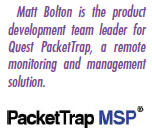See How Easily You Can Add VoIP To Your Managed Services Offering
By Matt Bolton, product development team leader, Quest PacketTrap
MSPs can play a key role in upgrading their customers’ phone systems and create another recurring revenue stream at the same time.
 When it comes to implementing a VoIP (voice over Internet Protocol) system, SMBs can face a few obstacles.
When it comes to implementing a VoIP (voice over Internet Protocol) system, SMBs can face a few obstacles.
First, SMBs should be prepared to encounter issues with performance. High-quality performance of a VoIP system is key for a business to function properly. Downtime for phone systems is not an option. However, performance is more often impacted by other network traffic, rather than the VoIP system. Poor functionality can occur when other routine events take place: users access a large Web server, a massive off-site backup is conducted in the middle of the day, or an internal IT team member is patching end user systems. Inversely, a new VoIP system could impact overall network functionality. For example, call centers may not have enough bandwidth to uphold Internet use as well as the daily deluge of phone calls processed.
SMBs are also challenged by supporting mobility for their end users. In today’s world of BYOD (bring your own device), end users want to be able to make and receive calls as they switch from device (a VoIP phone at a work station) to device (a work-issued smartphone). VoIP systems become more and more complex as each of these devices is leveraged. Therefore, systems become intricate networks as they balance calls made from a mobile device and support other functions such as voice-mail delivery.
MSPs Fill Unique Roll In VoIP Rollouts
A VAR or MSP (managed services provider) can be an important resource for an SMB as it can help with selection, deployment, and ongoing monitoring of a VoIP system.
In the initial procurement stage, MSPs act as trusted advisors for SMBs. After weighing their options and receiving offers from different VoIP providers, SMBs are left with the decision of which one to choose. MSPs can offer unbiased advice on which systems fit better for a company’s unique network and make sure they are not being oversold by the provider.
Before an RMM (remote monitoring and management) software deployment, an MSP can help a company determine whether its current network can support VoIP and advise on whether elements of an IT environment need to be upgraded in order to install VoIP. MSPs ease the challenging process of migrating from a traditional landline over to a VoIP system. Their key role in this transition is determining if a current system is up-to-par and can withstand the implementation of a VoIP system. It is a difficult task for an SMB to determine whether its network can support the bandwidth needed and if its day-to- day traffic would interfere with daily calls.
Once a VoIP system is installed, MSPs continue to monitor to make sure networks are running at peak performance and optimize functionality in the workplace by being able to proactively alert end users to issues that may cause downtime. MSPs can come in handy in this instance, because they can set alerts and monitor for traffic spikes, application use and bandwidth issues. RMM monitoring systems can provide detailed monitoring of VoIP quality metrics such as MOS (mean opinion score), Jitter, packet-loss, delay, and network utilization. In addition, there are reports and alerts on all VoIP-related voice metrics. Due to continually evolving technology, there is the challenge of effectively monitoring VoIP systems and ensuring there is adequate visibility into how the IT infrastructure and VoIP systems are working together, and monitoring systems can create the most efficient environment, enhance user satisfaction, and meet SLAs (service level agreements).
